The Sustainable Development Goal 5 (SDG 5) is initiated to “achieve gender equality and empower all women and girls”. The global SDG 5 consists of 9 targets (3 targets as means of implementation) and 14 indicators. The objectives of SDG 5 are expressed in terms of promoting gender equality highly at local and national levels, whereas the last three targets serve as the means of implementation to validate and assess the goal along the 14 indicators.1
Women’s equality and empowerment do not only have a substantial effect on sustainable growth and inclusive development but are also integral to all respective goals in the overall 2030 Agenda for Sustainable Development. The achievement of Goal 5 is a fundamental ground leading to the fulfillment of the other SDGs.2 In the course of SDG 5, separate targets incorporated with more measuring indicators are put all together in place.3
 |  | 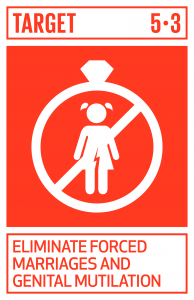 |
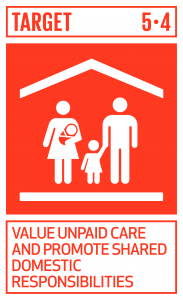 |  | 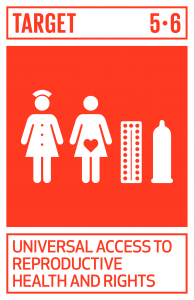 |
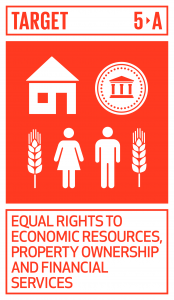 | 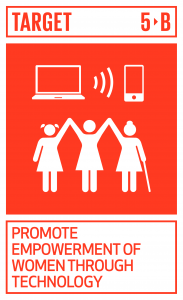 | 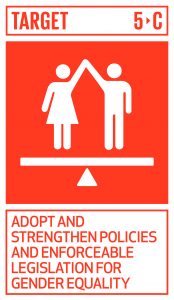 |
The SDGs also provide linkages and possibilities to address cross-sectoral challenges, and gender issues are represented in both a stand-alone goal as well as in other SDGs. For example, a draft report from the World Food Programme (WFP) introduces a cross-sector linkage of SDG 2 to SDG 5. The report indicates that gender inequalities can significantly affect access to food security and nutrition. Improving food security and nutrition will also combat poverty, reassure health quality and promote educational attainment. 4 Additional training for professional health staff on food security and nutrition are crucial so that monitoring and access to information on food nutrition can be established to women and children at the community level.5
Transition from the MDG 3 to SDG 5 targets in Cambodia
Millennium Development Goal 3 (Gender Equality and Empower Women) set a sole focus (3.A) on the elimination of gender inequalities in all levels of education by 2015. The global MDG 3 emphasized three aspects which aimed to increase the proposition of female participation in (i) education, (ii) wage employment exclusive from agricultural sector and (iii) seats in national parliament.6
The Cambodia Millennium Development Goal 3 (CMDG 3) followed these global components.7 Moreover, the Cambodian Government also introduced a national target (3.d) which aimed to promote the prevalence of violence against women and children into the CMDG 3.8
Cambodia was able to successfully achieve the first indicator (3.a), meaning that gender disparities in access to education by 2015 had been eliminated. The achievement of this indicator was also highly related to the implementation of CMDG 2 (achieve universal primary education).9
Significant improvements had been made by 2015 on gender empowerment in wage employment (3.b) and economic and political decision making (3.c). In fact, the participation of women in wage employment of all sectors was 42.2 percent in 2010 which was close to the 50 percent (2015 target), whereas contribution to wages by service sector was rather low, at 32 percent in 2013.10
The result of the last indicator (3.d – gender-based violence) was not available due to a lack of reliable data. Despite unspecific data, there are already some existing laws to tackle this serious issue. The unfinished business of CMDG 3 will be further addressed in the CSDG agenda, although challenges such as gender stereotypes and rooted cultural norm are visible and significant. Reliable data collection will also be prioritized.11
Localization of SDG 5 in Cambodia
Among the 9 targets and 14 indicators of global SDG 5, the Cambodian government has accepted 7 targets and 12 indicators into the CSDG framework.12
Similar to the other CSDGs, the localization from global SDG 5 into Cambodia’s national context was conducted with a rapid integrated assessment against the existing national strategy (Cambodia’s National Strategic Development Plan (NSDP) 2014-2018) and other relevant sector plans such as Neary Rattanak IV 2014 – 2018 for the readiness of CSDG 5.13
It was found that the National Development Plan and relevant sector strategies have raised about 78% of the CSDG 5 and other relevant people-related CSDGs (1, 2, 3, and 4).14
In the Socio-Economic Policy Agenda (Rectangular Strategy IV) of the current government, human resource development of the first rectangular is given the highest priority. It includes mainstreaming of gender equity in policy framework and national development plan which will lessen the gender gap in education, widen women entrepreneurship initiative, reduce domestic violence and sexual abuse against women and children and uplift social morality.
Below offers an overview of assessment and implemented strategies from the Royal Government of Cambodia and relevant bodies regarding specific targets and indicators of CSDG 5.15
Target 5.1 – to end all forms of discrimination against all women and girls everywhere.
It is necessary to “promote and enforce existing laws and legal frameworks” (indicator 5.1.1), such as CEDAW Convention and ILO’s guideline on Equality and non-discrimination at work in Cambodia. Reducing (sexual) harassment at workplace creates a welcoming working atmosphere and has positive potential to eliminate gender-based discrimination; for example, by introducing a ‘whole of organization’ approach.16
Target 5.2 – to eliminate all forms of violence against women and children everywhere, including trafficking and sexual and other types of exploitation.
Domestic violence in Cambodia had decreased from 41,474 cases in 2006 to 35,408 cases in 2009 or by 29 percent. Increasing awareness that domestic violence against women is a crime has been made.17 Existing strategic plans such as National Action Plan to prevent violence against women 2014-2018 and Referral Guidelines for Women and Girl Survivors of Gender-based Violence will aid prevention of violence toward girls and women and also provide assistance to the victims of domestic violence.
Target 5.3 – to eliminate all harmful practices, such as child, early and forced marriage and female genital mutilation.
This localized target stresses out the child marriage issue in Cambodia. According to the Cambodia Demographic and Health Survey (CDHS) 2014, 15.6% of 15 to 19-year-old respondents were in a union.18
Target 5.4 – to instill the value of unpaid care and domestic work and promotion of shared responsibility within the household.
High responsibilities in unpaid domestic and care work continue to hinder women’s economic empowerment. In Cambodia, women undertake household responsibility four times more than men in 2015.19
Target 5.5 – to ensure women’s full and efficient participation in economic and politics, notably ratio of seats held by women in the legislative institutions (indicator 5.3.1), female civil servants holding high position in public sectors (indicator 5.3.2) and women in Commune or Sangkat council (indicator 5.3.3).
Since 2008 until 2013, the percentage of women in the National Assembly decreased from 21.10 percent in 2008 to 20.32 percent in 2013, while 14.75 percent exhibited a straight linear representing a stable percentage of women senators from 1999 until 2012.20 In addition, the 2018 national election revealed that the total proportion of women Member of Parliament amounted to 20 percent of female representatives. This number decreased slightly by 0.3 percent if compared to the result in 2013 (20.3 percent). 21
Target 5.6 – to ensure universal access to sexual and reproductive health and reproductive rights.
A recent data from 2014 indicated that only 13 percent of married women in Cambodia who did not want any more children were not using any form of contraception due to lack of information (indicator 5.6.1).22
However, it was found that the localized target 5.3 and 5.4 are not addressed in the national strategic plan. These missing gaps result from a much shorter time frame of national strategies and action for the period 2014 – 2018 in NSDP and other relevant sector strategies, which make these goals, targets and objective less ambitious than those given in the SDG Agenda.23
Means of Implementation of SDG 5 in Cambodia
The last three targets of the SDG 5 aim at developing the means of implementation to achieve gender equality in the 2030 Agenda for sustainable development.
In the process of localization, the Royal Government of Cambodia has approved adaptation of merely one means (5.c) for implementing the CSDG 5.24
The localized target 5.c seeks to adapt and strengthen sound policies and enforceable legislation for the promotion of gender equality and the empowerment of all women and girls at all levels. It comes with two indicators:
- The indicator 5.c.1 is to be able to track and allocate budget systematically that promotes gender equality and women empowerment by ministries and agencies.
- The indicator 5.c.2 is to have Gender Mainstreaming Strategic Plan developed and implemented by Line Ministries (LMs) and Line Agencies (LAs).
The implementation of indicator 5.c.1 falls under the joint responsibility of three ministries such as Ministry of Economic and Finance (MEF), Cambodian National Council for Women (CNCW) and Ministry of Women’s Affairs (MOWA); and indicator 5.c.2 by MOWA and Ministry of Civil Service (MCS).25
Development partners as well as local NGOs also play a key role in driving the implementation of the CSDG 5. USAID has offered a million dollar grant for a collective project initiated by Gender and Development in Cambodia (GADC) in partnership with the Amara Cambodian Women’s Network for Development (AMARA), the Alliance for Conflict Transformation (ACT) and Women Peace Makers (WPM) to promote the leadership and engagement of women in politics (target 5.C) in six provinces.26
In the mission to respond most effectively to Cambodia’s development needs, priorities and aspirations, UNESCO presents a Strategic Framework (2019-2023) which will engage comprehensive interventions of its priority areas regarding SDGs in Cambodia.27 This framework will influence the integration and enforcement of the global target 5.b (enhance the use of enabling technology to promote the empowerment of women) and target 5.c in the upcoming National Development Plan (2019-2023).
Monitoring and evaluation of SDG 5 in Cambodia
The Ministry of Women’s Affairs (MoWA) is the leading institution in supporting CSDG 5. This goal requires involvement from various institutions and line-ministries, as gender equality is essential in every aspect of sustainable and inclusive development.28
Other responsible agencies for CSDG 5 are Technical Working Group Gender – Gender-Based Violence (TWGG-GBV), Ministry of Planning (MoP), National Institute of Statistics, Ministry of Labour and Vocational Training (MOLVT), Ministry of Health, National Committee for Sub-National Democratic Development (NCDDS) and other Line-Ministries.29
The progressive monitoring and evaluation of most indicators will be gathered and updated every 5 years, although a few indicators (5.6.2, 5.c.1 and 5.c.2) require a more frequent follow-up, specifically every year.30 In contrast to other CSDGs, the 5-year interval of data collection for the CSDG 5 starts from 2018 to 2030.
Table 1: Monitoring of Targets and Indicators of the CSDG 531
Targets | Indicators | Unit | 2015 (baseline) | 2018 | 2023 | 2028 | 2030 |
5.1 End all forms of discrimination against all women and girls everywhere. | 5.1.1 whether or not legal frameworks are in place to promote, enforce and monitor equality and non-discrimination on the basis of sex | Number | 50 (2016) | 55 | 55 | 60 | 60 |
5.2 Eliminate all forms of violence against all women and girls in the public and private spheres, including trafficking and sexual and other types of exploitation | 5.2.1 Proportion of ever-partnered women and girls aged 15 years and older subjected to physical, sexual or psychological violence by a current or former intimate partner in the previous 12 months, by form of violence and by age. | % | 30.8 (2016) | 30.0 | 28.0 | 25.0 | 25.0 |
5.2.2 proportion of women and girls aged 15 years and older subjected to sexual violence by persons other than an intimate partner in the previous 12 months and by age. | % | 0.1 (2016) | N/A | N/A | N/A | 0.05 | |
5.3 Eliminate all harmful practices, such as child, early and forced marriage and female genital mutilation. | 5.3.1 Proportion of women aged 20-24 years who were married or in a union before age 18 years old. | % | 1.9 (2016) | 18.0 | 1.70 | 1.60 | 1.60 |
5.4 Recognize and value unpaid care and domestic work through the provision of public services, infrastructure and social protection policies and the promotion of shared responsibility within the household and the family as nationally appropriate. | 5.4.1 Number of legal and policy measures to address and recognize work-life balance, and unpaid care and domestic works, and promote women’s increased access to decent employment. | Number | 5 (2016) | 7 | 9 | 10 | N/A |
5.5 Ensure fully and efficiently participation of women and equal opportunity for leadership at all levels in economic, politicalique and public life. | 5.5.1 Proportion of seats held by women in National Assembly. | % | 17.81 (2016) | 25.0 | 30.0 | 35.0 | 35.0 |
5.5.2 Proportion of women Secretary and Under-Secretary of State | % | 16.25 (2016) | 21.0 | 26.0 | 31.0 | 31.0 | |
5.5.3 Proportion of women in Commune/ Sangkat council. | % | 16.75 (2017) | N/A | N/A | N/A | 30.0 | |
5.6 Ensure the access to sexual and reproductive health and reproductive rights as universal agreed on the Programme of Action of the International Conference on Population and Development and the Beijing Platform for Action and other relevant documents. | 5.6.1 The proportion of women aged 15 to 49 who own decision relating to the use of contraception and reproductive health care. | % | 57.6 (2016) | 77.0 | 79.0 | N/A | 83.0 |
5.6.2 The number of laws , policies , plans and legal regulations that ensure that all women have access to information , education and sexual and reproductive health services. | Number | 10 (2016) | 12 | 15 | N/A | 20 | |
5.c Adopt and strengthen sound policies and enforceable legislation for the promotion of gender equality and the empowerment of all women and girls at all levels. | 5.c.1 Number of institutions with a system to track and allocate budget to promote gender equality and empower women. | Number | N/A | 3 | 5 | N/A | 9 |
5.c.2 Number of line Ministries, Line Agencies have development and Implement Gender Mainstreaming Strategic Plan. | Number | 6 (2016) | 6 | 12 | 17 | 19 |
References
- 1. Sustainable Development Knowledge Platform, ”Sustainable Development Goal 5”. Accessed on March 2019.
- 2. UN Women. “Sustainable Development Goal 5: Gender equality”. Accessed on March 2019
- 3. UNDP Cambodia. “Sustainable Development Goals”. Accessed on March 2019.
- 4. World Food Programme, “Draft Cambodia country strategic plan (2019–2023)”. Accessed on March 2019.
- 5. Ministry of Women’s Affairs 2014 “Gender and Health”, policy brief 5. Accessed on March 2019.
- 6. The World Federation of United Nations Associations (WFUNA), “Millennium Development Goal #3”. Accessed on March 2019.
- 7. United Nations, “MDG Country Progress Snapshot: Cambodia”. Accessed on March 2019.
- 8. Royal Government of Cambodia 2019, “Cambodian Sustainable Development Goals Framework 2016-2030”. Accessed on March 2019.
- 9. Ibid
- 10. Ibid
- 11. Ibid
- 12. Royal Government of Cambodia 2019, “Cambodian Sustainable Development Goals Framework 2016-2030”. Accessed on March 2019.
- 13. United Nations of Development Programme (UNDP), “Rapid Integrated Assessment – Cambodia SDG Profile”. Accessed on March 2019.
- 14. Ibid
- 15. Royal Government of Cambodia 2019, “Cambodian Sustainable Development Goals Framework 2016-2030”. Accessed on March 2019.
- 16. CARE Australia, “What works? Reduce Sexual Harassment in the workplace”. Accessed on March 2019.
- 17. Ministry of Planning 2013, “Annual Progress Report”. Accessed on February 2019
- 18. UNFPA and National Institute of Statistics 2016, “Sexual and Reproductive Health of Adolescents and Youth in Cambodia Analysis of 2000-2014 Cambodia Demographic and Health Survey Data”. Accessed on March 2019.
- 19. UNDP, “Rapid Integrated Assessment – Cambodia SDG Profile”. Accessed on 20 March 2019.
- 20. Kem Keothyda & Chea Malika, “Progress of Women in Politics in Cambodia”, Parliamentary Institute of Cambodia (2016), 3. Accessed February 2019.
- 21. World Bank, “Proportion of seats held by women in national parliaments (%)”. Accessed on February 2019
- 22. UNFPA Cambodia, “Sexual & reproductive health”. Accessed on March 2019.
- 23. UNDP, “Rapid Integrated Assessment – Cambodia SDG Profile”, 11. Accessed on March 2019.
- 24. Royal Government of Cambodia 2019, “Cambodian Sustainable Development Goals Framework 2016-2030”. Accessed on March 2019.
- 25. Royal Government of Cambodia 2019, “Cambodian Sustainable Development Goals Framework 2016-2030”. Accessed on March 2019.
- 26. Long Kimmarita, “$1M for women in politics project”, The Phnom Penh Post. Accessed on March 2019
- 27. UNESCO Office Phnom Penh 2018, “UNESCO country strategy for Cambodia 2019-2023”. Accessed on March 2019.
- 28. BRIDGE Development-Gender 2016. “Four reasons why gender is an essential part of sustainable development”. Accessed on March 2019.
- 29. Royal Government of Cambodia 2019, “Cambodian Sustainable Development Goals Framework 2016-2030”. Accessed on March 2019.
- 30. Ibid
- 31. Ibid

